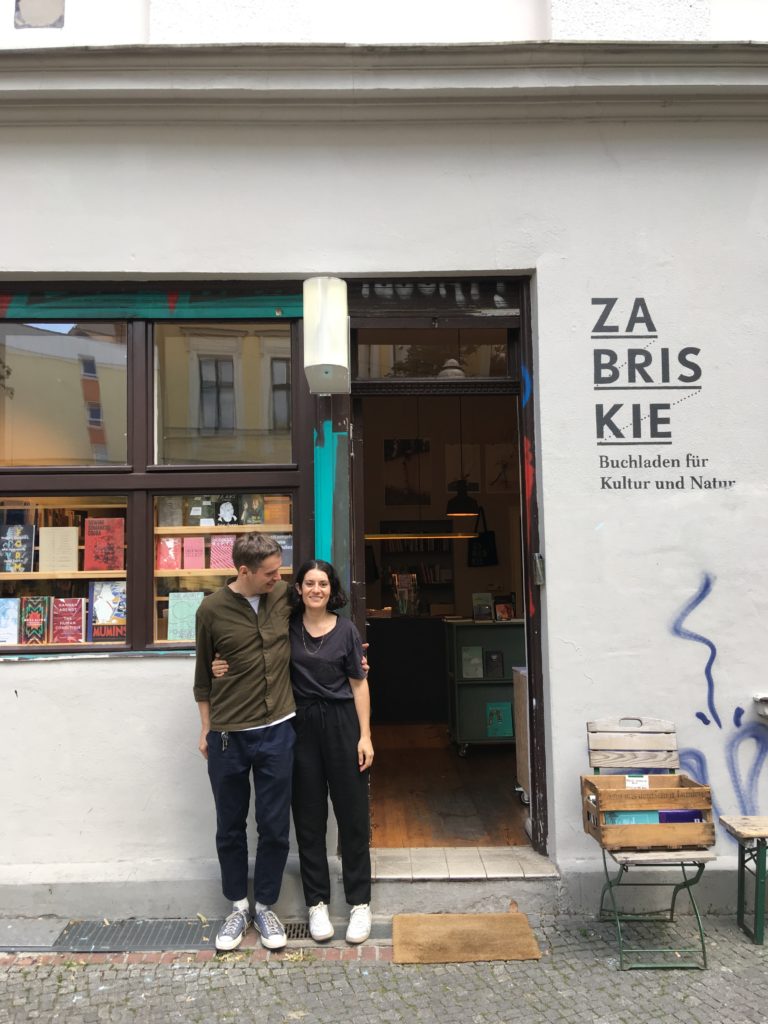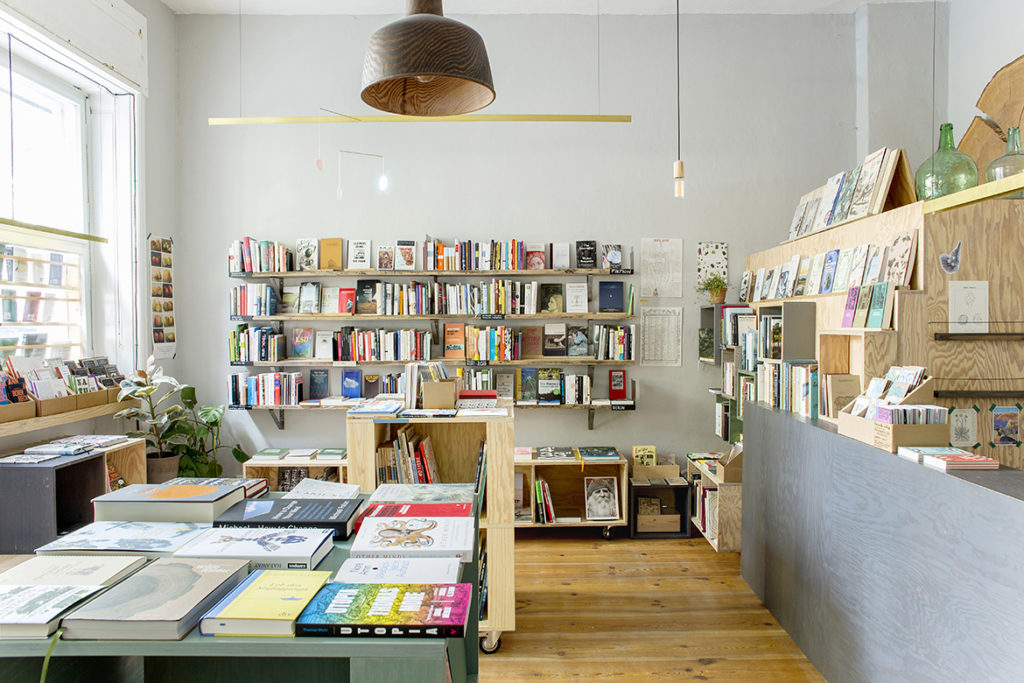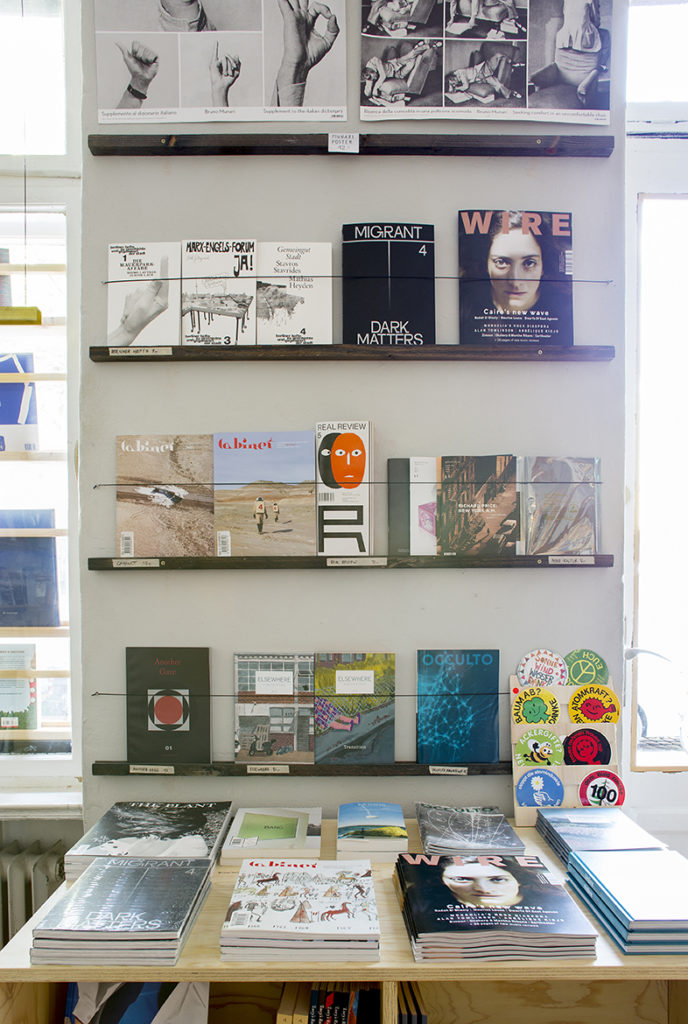Emma Warren chats books, music and favourite Berliner nature spots with the owners of paperback paradise Zabriskie. With photos by Martina della Valle.

Buchladen für Kultur und Natur. That’s what is says on the front of serene bookstore Zabriskie in Kreuzberg, Berlin. Inside, co-founders Lorena Carràs and Jean-Marie Dhur have hand-picked a roomful of books, pamphlets and artist-made publications that comfortably span natural history, nature writing, underground music and film and utopian, radical politics alongside CBTR regulars like Richard King. The shelves at Zabriskie contain the naturally weird and the culturally wired.
The shop opened in 2013 and is named after the area 100 miles north of Las Vegas in Death Valley where French philosopher Michel Foucault dropped acid and which film-maker Michelangelo Antonini used in the title of his 1970 film Zabriskie Point.
In short, it’s a paperback paradise that makes good on the promise stencilled by the entrance, bridging the unnatural divide between nature and culture. I dropped by to have a chat with the owners.
Your book shop is lovely! How did it come into existence?
After being active for many years in Berlin’s different cultural and artistic scenes, mostly below the radar, and after not finding certain books in other bookshops, we thought about starting one ourselves. A bookshop that is like our private library, with only books that we like, and the topics that interest us. And we wanted to start something, that gives us almost complete freedom of doing it as we want to do it.
Which are the most popular sections?
Many customers like interdisciplinary books like Arts of Living on a Damaged Planet, The Mushroom at the End of the World or Against the Anthropocene, in which anthropology, ecology and arts come together. Nature writing and landscape writing are also among the popular sections. And books by smaller publishers that are hard to find in “normal” bookshops. And Matthes & Seitz’s Naturkunden series.
What have you been recommending to readers recently?
Our recommendations are many, and change from week to week – depending on the good books that are new in our selection. Some of our all time recommendations are the Emergence Magazine #1, The Mushroom at the End of the World, The Living Mountain by Nan Shephard, Richard King’s The Lark Ascending, the animal and plant portraits by German publisher Matthes & Seitz Berlin, Andreas Weber’s Indigenialität, the Analog Sea Reviews; Rebecca Solnit’s books, and many more. The recommendation list is long!

You’ve got a nice-looking coffee machine in the shop. What are your caffeine needs like?
One espresso after opening the shop, and then another one at half-time. Sometimes with a little oat milk.
What relationship do you think Berliners have with nature? And with the overlap between nature and culture?
Compared to other bigger cities, Berlin is very green. There are many little green zones, many parks and even forests in the city, which are all well visited by the Berliners. More and more guided tours and walks about the Stadtnatur [city nature] are offered, and they are quite well attended. Many people we know have a deeper connection to nature, to animals and plants, and also love to be in the surrounding countryside in Brandenburg. But surely many other Berliners don’t care so much.
You’re based in Kreuzberg, Berlin, a pretty urban part of what strikes me as a pretty urban city. What can you tell us about nature near you?One nice area is around the Landwehrkanal, which starts in Kreuzberg and goes for 11km to Charlottenburg, where it flows back into the Spree river. At Urbanhafen, which is not far away from the shop, the canal is a bit wider, and some sailing boats are anchoring there, and you can have the feeling of being in a city close to the sea. Since a few years, we are organising bird walks and plant walks in the neighbourhood, and through these walks, you can find out that there are many many healing plants growing in our area, and many birds live there with us. From time to time, you can even see goshawks in the neighbourhood! And some foxes live here as well.
Where are the nature spots you feel very connected to?
Among our favourite spots or areas are the Tegeler Fliess, a swampy area in the north of the city, which is beautiful and very interesting. A quite new nature space is the former airport field of Tempelhof, which is now a public park, where you can encounter owls, hawks, ravens and of course many crows, and where a big field is fenced, because it is nesting ground for skylarks. We also go frequently into the Grunewald forest, the biggest one in Berlin. But if possible, we go to somewhere outside of the city, like Märkische Schweiz or Schorfheide or Uckermark, which are all not so far away from Berlin, and easily reachable by train.

Any other Berlin bookshops you’d like to recommend to Caught by the River readers?
Check out Pro Qm, a very nice bookshop that has a focus on urbanism, architecture, popular culture, economical criticism. Books People Places has a similar focus, but is smaller. B_Books in Kreuzberg for leftfield political and cultural studies. And you find many good second-hand bookshops in Berlin, but of course there the books are mostly in German.
We love music. What’s on your playlist at the moment?
Ernest Hood’s Neighborhoods
Carlos Maria Trindade’s & Nuno Canavarro’s Mr. Wollogallu
Emily A. Sprague’s Water Memory
Jonny Trunk’s 20,000 Leagues Under The Sea
Wilson Tanner’s II
Arthur Verocai’s self-titled album
Kate Bush
The Pilotwings’s Sanpo 053 mix
Esclé’s When you sit in front of a lake and play music for sunrise
Visible Cloaks’s Music Interiors Vol. 2: Interni Italiani
What should we do next time we come to Berlin?
Take a two hour walk along the Tegeler Fliess, visit the Botanical Garden, come to Zabriskie.
*
Zabriskie are at Manteuffelstr. 73. 10999 Berlin. Join their newsletter here.